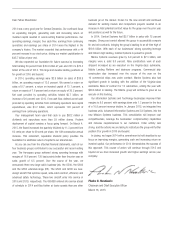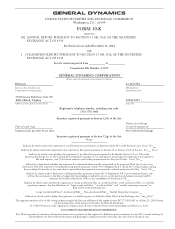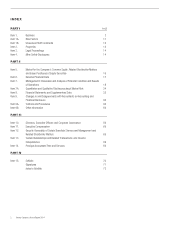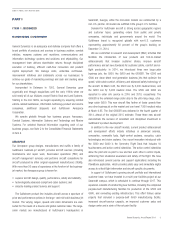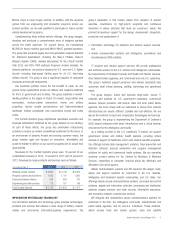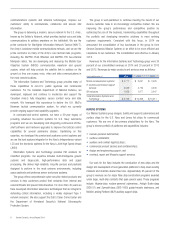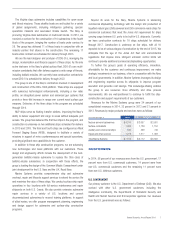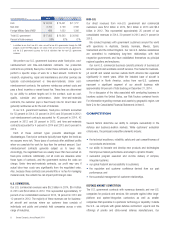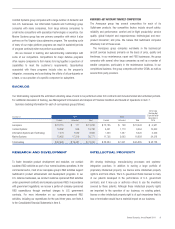General Dynamics 2014 Annual Report Download - page 10
Download and view the complete annual report
Please find page 10 of the 2014 General Dynamics annual report below. You can navigate through the pages in the report by either clicking on the pages listed below, or by using the keyword search tool below to find specific information within the annual report.
Year Ended December 31 2014 2013 2012
DoD $ 14,516 $ 15,441 $ 17,217
Non-DoD 2,750 2,790 2,382
Foreign Military Sales (FMS)* 689 1,032 1,206
Total U.S. government $ 17,955 $ 19,263 $ 20,805
Percent of total revenues 58% 62% 67%
* In addition to our direct non-U.S. sales, we sell to non-U.S. governments through the FMS
program. Under the FMS program, we contract with and are paid by the U.S. government,
and the U.S. government assumes the risk of collection from the non-U.S. government
customer.
We perform our U.S. government business under fixed-price, cost-
reimbursement and time-and-materials contracts. Our production
contracts are primarily fixed-price. Under these contracts, we agree to
perform a specific scope of work for a fixed amount. Contracts for
research, engineering, repair and maintenance and other services are
typically cost-reimbursement or time-and-materials. Under cost-
reimbursement contracts, the customer reimburses contract costs and
pays a fixed, incentive or award-based fee. These fees are determined
by our ability to achieve targets set in the contract, such as cost,
quality, schedule and performance. Under time-and-materials
contracts, the customer pays a fixed hourly rate for direct labor and
generally reimburses us for the cost of materials.
In our U.S. government business, fixed-price contracts accounted
for 53 percent in 2014, 54 percent in 2013 and 56 percent in 2012;
cost-reimbursement contracts accounted for 43 percent in 2014, 42
percent in 2013 and 39 percent in 2012; and time-and-materials
contracts accounted for 4 percent in 2014 and 2013 and 5 percent in
2012.
Each of these contract types presents advantages and
disadvantages. Fixed-price contracts typically have higher fee levels as
we assume more risk. These types of contracts offer additional profits
when we complete the work for less than the contract amount. Cost-
reimbursement contracts generally subject us to lower risk.
Accordingly, the negotiated fees are usually lower than fees earned on
fixed-price contracts. Additionally, not all costs are allowable under
these types of contracts, and the government reviews the costs we
charge. Under time-and-materials contracts, our profit may vary if
actual labor-hour costs vary significantly from the negotiated rates.
Also, because these contracts can provide little or no fee for managing
material costs, the content mix can impact profit margin rates.
U.S. COMMERCIAL
Our U.S. commercial revenues were $5.3 billion in 2014, $5.4 billion
in 2013 and $3.8 billion in 2012. This represented approximately 17
percent of our consolidated revenues in 2014, 18 percent in 2013 and
12 percent in 2012. The majority of these revenues are for business-
jet aircraft and services where our customer base consists of
individuals and public and privately held companies across a wide
range of industries.
NON-U.S.
Our direct revenues from non-U.S. government and commercial
customers were $7.6 billion in 2014, $6.3 billion in 2013 and $6.4
billion in 2012. This represented approximately 25 percent of our
consolidated revenues in 2014, 20 percent in 2013 and 21 percent in
2012.
We conduct business with government customers around the world
with operations in Australia, Canada, Germany, Mexico, Spain,
Switzerland and the United Kingdom. Our non-U.S. defense subsidiaries
are committed to maintaining long-term relationships with their
respective governments and have established themselves as principal
regional suppliers and employers.
Our non-U.S. commercial business consists primarily of business-jet
aircraft exports and worldwide aircraft services. The market for business-
jet aircraft and related services outside North America has expanded
significantly in recent years. While the installed base of aircraft is
concentrated in North America, orders from non-U.S. customers
represent a significant segment of our aircraft business with
approximately 60 percent of total backlog on December 31, 2014.
For a discussion of the risks associated with conducting business in
locations outside the United States, see Risk Factors contained herein.
For information regarding revenues and assets by geographic region, see
Note Q to the Consolidated Financial Statements in Item 8.
COMPETITION
Several factors determine our ability to compete successfully in the
defense and business-aviation markets. While customers’ evaluation
criteria vary, the principal competitive elements include:
•the technical excellence, reliability, safety and cost competitiveness of
our products and services;
•our ability to innovate and develop new products and technologies
that improve mission performance and adapt to dynamic threats;
•successful program execution and on-time delivery of complex,
integrated systems;
•our global footprint and accessibility to customers;
•the reputation and customer confidence derived from our past
performance; and
•the successful management of customer relationships.
DEFENSE MARKET COMPETITION
The U.S. government contracts with numerous domestic and non-U.S.
companies for products and services. We compete against other large-
platform and system-integration contractors as well as smaller
companies that specialize in a particular technology or capability. Outside
the U.S., we compete with global defense contractors’ exports and the
offerings of private and state-owned defense manufacturers. Our
8 General Dynamics Annual Report 2014


